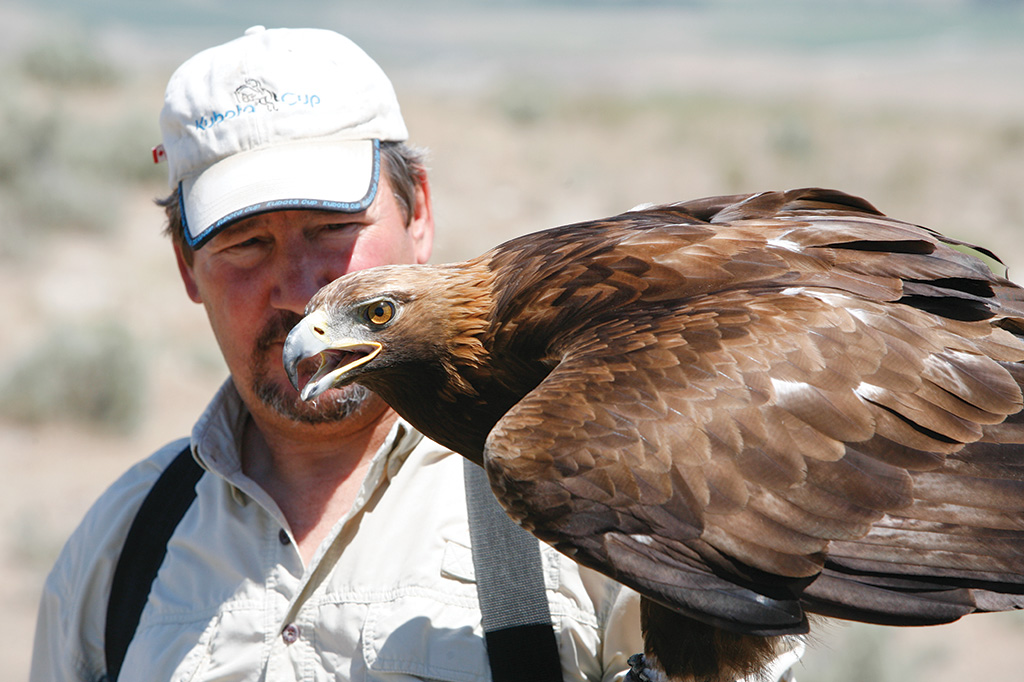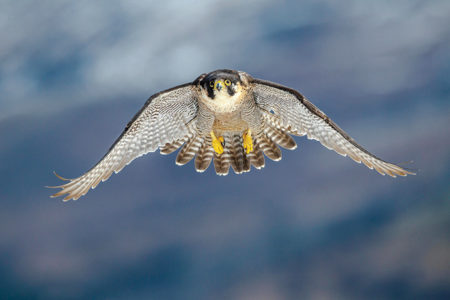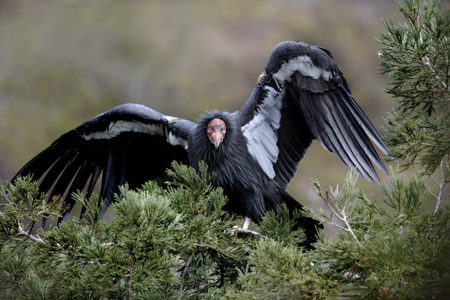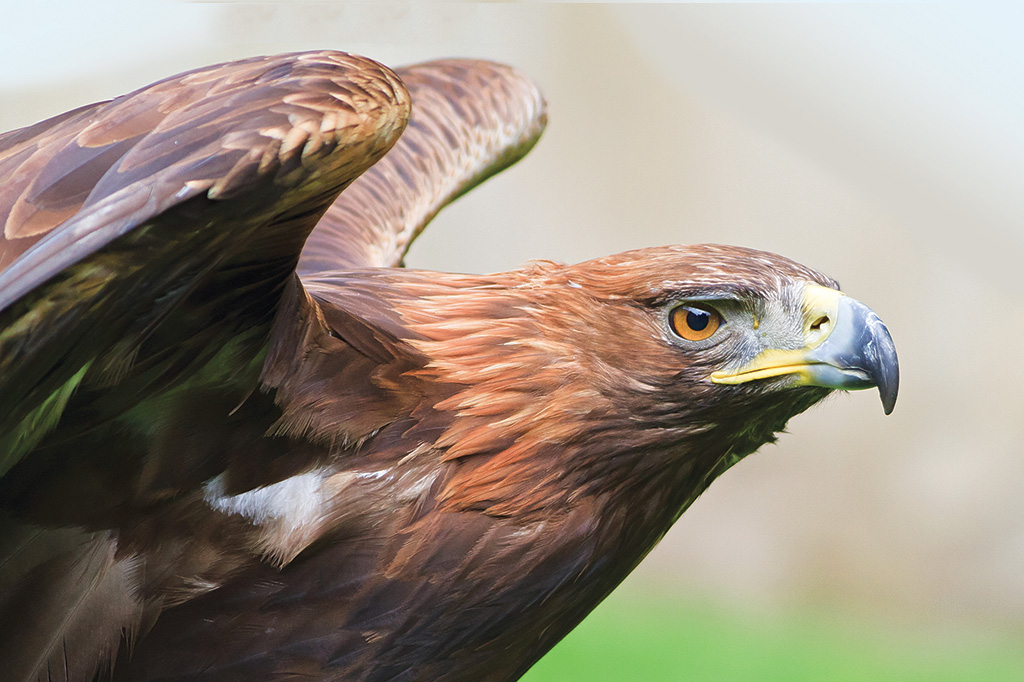On a warm and dry August day near Vale, Oregon, Joe Atkinson walks to the edge of a long ridge and casts Widow, a magnificent, nearly 10-pound female golden eagle, off his wrist into a light blue sky. With one step and an upward sweep of her wings, Widow is airborne, her wings stretched to over six feet and her shadow gliding low along the ridge. She slides off, soaring along the ridgeline in search of a thermal to carry her up above the desert landscape that stretches from the western border of Idaho into Oregon.
This is prime raptor country, a sagebrush sea loaded with ground squirrels, marmots, grouse, prairie dogs and jackrabbits (primary golden eagle prey), as well as other small birds and mammals. As a golden eagle, Widow is perfectly adapted to thrive in this environment.
Birds of prey, or raptors (derived from the Latin rapere, meaning “to seize” or “take by force”), include eagles, hawks, falcons, vultures and owls, and are defined by their keen vision, powerful talons and sharp, curved beaks. From her height of 1,200 feet, Widow can see vividly, and with exact precision, a rabbit that is over a mile away, which is approximately equivalent to our seeing a spider on the ground from the top of a 10-story building.
Equipped with broad, long wings with almost finger-like primary feathers at the tips, Widow is an expert flier capable of soaring 30 mph and gliding in a hunt at around 100 mph. Golden eagles possess astonishing speed and maneuverability for their size and, when in a full stoop (diving on prey), can reach speeds of up to 200 mph, making it one of the fastest moving animals on earth (behind the peregrine falcon, another bird of prey that has been clocked diving at speeds over 225 mph).
The heat has been rising all afternoon and Widow has found a thermal (columns of hot rising air that create lift). Within seconds, she has climbed hundreds of feet, being pulled like Icarus toward the sun and gaining height with every turn. Soon, she is barely visible, a tiny speck above the desert, marked only by a flash of wing that catches the blaze of the sun for an instant and then, just as quickly, disappears.
Joe Atkinson has lost sight of his bird. Atkinson, a master falconer based in Vale, Oregon, who has been working with eagles for over 40 years, is not worried. He and his wife Cordi, also a master falconer and retired clinical scientist, have developed a flight training and conditioning program in conjunction with the California Foundation for Birds of Prey (CFBP), to help rehabilitate golden eagles—those abandoned, sick or injured—so that they are better equipped with the skills needed to be released into the wild. To date, the Atkinsons have reconditioned and released more than 30 birds into the wild, but it is a long and sometimes heartbreaking commitment.
There is movement in the sagebrush and, moments later, as a jackrabbit begins darting between sagebrush in a mad dash to its burrow, Widow drops like the blade of a knife from behind the sun. Her timing is perfect and her talons sharp. Even with the sagebrush cover, the jackrabbit doesn’t stand a chance.

Master falconer Joe Atkinson takes “Widow” to the border of Idaho and Oregon for some hunting exercise.
Birds of Prey as a Sentinel Species
Known as the “King of the Sky,” or the “War Eagle,” golden eagles and other birds of prey have been both revered and feared for their great strength, size and power. In Greek mythology, a giant golden eagle served as the personal messenger of Zeus and was placed amongst the stars as the constellation Aquila, alongside its consort, the heavenly vulture, Lyra. Ancient texts tell of how the eagle alone could look into the sun, and the North American legend of the “thunderbird” speaks of a mythical-super eagle responsible for creating thunder and lightning. Golden eagles are also at the top in terms of biological dominance and have been known to attack other hawks and falcons, and even bald eagles that enter their territory.
Yet as powerful and adept as eagles and other birds of prey are in the animal kingdom, much of their survival depends in large part upon various human interactions. Many threats to raptors are human caused—including habitat loss, nest disturbance, environmental contaminants, persecution, electrocution and collisions (with aircraft, automobiles and, the most recent potential danger, wind turbines).
As top predators, raptors are considered “sentinel species”—sensitive indicators of the health of our environment. This is especially true for the larger raptors like eagles and vultures that reproduce more slowly and tend to be more sensitive to change in the environment.
Boise-based U.S. Geological Survey wildlife biologist Todd Katzner, who has collaborated on studies ranging from ecosystem balance and the effects of fire on sagebrush habitat for raptors, to golden eagle mortality and the continental-scale consequences of local wind-energy generation, calculates that at least 30 of the 75 currently recognized eagle species worldwide are of conservation concern. Vultures, in particular, are at high risk, and the International Union for the Conservation of Nature (IUCN) lists 73 percent of the world’s 22 vulture species as being of significant conservation concern.
“Birds of prey are good indicators of biodiversity and ecosystem function and pollution,” explained Katzner. “Birds of prey often serve as umbrella species (species used in the stead of many species for the purposes of making decisions concerning conservation.) There are clear associations between things that are real problems for humans and things that are real problems for raptors.”
Take, for example, the history of the bald eagle. In the early 1900s, the bald eagle was considered a threat to human interests due to perceived predation on livestock and fisheries, and many states had established bounties that paid for their extermination.
After decades of suffering persecution through shooting, poisoning and trapping, our national symbol was protected under the Bald Eagle Protection Act in 1940, which also established protection for golden eagles, whose plumage coloring is similar to that of immature bald eagles.
Bald eagle populations began declining again in the ‘50s and ‘60s due to widespread agricultural applications of the insecticide dichloro-diphenyl-trichloroethane (DDT). The effects of this chemical, which entered the food chain and caused avian reproductive failure, were so severe that there were only 487 nesting pairs of bald eagles in the lower 48 states in 1963, leading the bird fo the national seal of the United States to become one of the first species listed on the Endangered Species Preservation Act in 1967 (precursor to the Endangered Species Act of 1973).
Raptor issues with DDT also opened the eyes of the public to the adverse effects of mass applications of pesticides, as well as the concept of bioaccumulation (the buildup of toxic substances in tissues at a rate faster than the rate of excretion, which is a phenomenon that tends to magnify at higher levels in organisms higher up the food chain, such as raptors or humans). As a result, in 1972, the Environmental Protection Agency (EPA) issued a ban on all agricultural uses of DDT.

DDT had a dramatic effect on the peregrine falcon in the U.S.
Captive Propagation and Falconry
DDT also had a dramatic impact on the American peregrine falcon, which, by 1964, had become extinct east of the Mississippi and had been reduced to 324 known nesting pairs in the Western U.S. “The peregrine falcon was one of the first animals put on the ESA,” said Erin Katzner, director of community engagement and curator of birds for The Peregrine Fund (TPF), which is located at the World Center for Birds of Prey in Boise, Idaho. (Katzner is married to Todd Katzner of the USGS.) “It was also one of the first (species), and one of the very few that has been taken off the endangered species list.”
In fact, the peregrine falcon was removed from the federal list of threatened and endangered species effective August 25, 1999—just 29 years after it was first listed. And it was The Peregrine Fund that was largely responsible for the bird’s speedy recovery, along with a remarkable man by the name of Tom Cade who brought the Peregrine Fund to Idaho.
Recognized worldwide for having developed captive breeding and release programs for birds of prey at Cornell University in the 1960s, Cade became the father of the peregrine falcon’s recovery, first in the eastern United States, and then across much of the species’ range in North America.
“I had a lifelong interest in birds of prey since the time I was about 9 years old,” said Cade last August. “Through falconry, initially, and then later as a biologist in college and graduate school.”
Cade’s genius was in bringing that lifelong love of birds of prey and his experience with falconry to his raptor biology work. It is similar in concept to the rehabilitation work that Joe and Cordi Atkinson are now undertaking by using falconry techniques to provide eagles with the skills needed to survive in the wild; but at the time, it was groundbreaking.
“Tom Cade and his team were able to breed peregrine falcons in captivity, which now seems commonplace,” Erin Katzner reflected, “but at the time nobody had ever done it before, so it was quite a breakthrough in scientific methods.”
In typical fashion, Cade, who has won numerous awards for his work, credits the original idea to other team members: chiefly, to Don Hunter, a lawyer from Cornell who was, according to Cade, also a topnotch falconer. The two established the Raptor Research Foundation in 1966 and decided to collaborate on the idea of captive propagation, which eventually led to the founding of The Peregrine Fund and the complete recovery of the peregrine falcon.
“Most people thought it would be impossible to bring peregrines back from extinction because they thought, first, you could never breed enough of them; and second, even if you did, they would never survive on their own in the wild, or if they did survive in the wild, they wouldn’t be able to breed,” said Cade, who is now in his 90s.
“All of these different stages seemed impossible to overcome, but we just kept proving them wrong and eventually many of them joined us,” he added. “It was a lot of fun, actually.”
“We had the first successful breeding in 1973,” recalled Cade. “It took us three years and we still had a lot to learn, but we raised around 21 peregrines that year from four pairs and soon we were producing up to 100 birds per year, releasing them into the wild.”
Raptor Recovery and The Peregrine Fund
By 1985, Cade and his team had released more than 1,300 birds into the wild and, by 1999, the peregrine falcon had recovered enough to be removed from the ESA. It was a triumph for science—a breakthrough made possible by a man with a passion for these birds and the vision to bring falconry techniques and ideas to scientific efforts. And because Idaho is prime raptor country—home to 31 species of raptors, as well as North America’s highest density of nesting raptors—most of that work happened right in the center of Idaho, at The Peregrine Fund headquarters in Boise.
As the story is told, The Peregrine Fund was founded in 1970 by Cade after a couple of young boys read an article in Boys Life about his work trying to save the peregrine falcon. The boys went door to door in their neighborhood raising money for Cade, then mailed it to him. It was only as he was opening a bank account to deposit the funds and he was asked to furnish a name that The Peregrine Fund was founded.
“Every time I hear that story, it gives me chills because it answers the question of ‘what can I do?’” said Erin Katzner. “When you think that some small action like that can turn into a huge multi-national organization that has gone on to not only save the peregrine falcon in the United States, but also saved Mauritius kestrels and three species of Asian vultures from extinction, then you realize you have the potential to actually change the future of our planet by ensuring that these birds still exist.”
“The Peregrine Fund has always been grounded in both science and falconry,” asserted Erin Katzner, citing Cade as the impetus for that philosophy and adding that they have learned how important it is to understand the science of declining populations.
She cites multiple case studies as examples, starting with TPF’s work with the East Indian vulture and the California condor. The latter had declined to 22 breeding pairs in the wild by 1982. Currently, The Peregrine Fund maintains the world’s largest captive breeding program of California condors—they had 13 eggs laid this past April, and those chicks will eventually be released back into the wild. But in the beginning, their conservation efforts were ineffective because even with newly released captive-bred condors, condor numbers continued to decline.

In 2007 it was discovered that California condors were dying from lead poisoning.
Science Before Conservation
“We had to determine why they were dying,” stated Katzner, “otherwise, our conservation efforts were not having any quantifiable effect.”
The science had to come first, so the focus shifted.
As it turns out, California condors were dying from lead poisoning. In a scientific paper published by Cade in the Journal of Wildlife Management in 2007, he cites evidence of the exposure of free-flying California condors to lead from spent ammunition and the need for clinical intervention and chelation treatments (chemical removal of lead from the bloodstream).
“One of the things we didn’t realize was that these scavengers were coming down to feed on the leftovers from animals that had been shot with lead ammunition,” said The Peregrine Fund’s Katzner. “And not just condors, but anything that scavenges, which includes bald eagles and vultures, hawks and kestrels. (They) often feed on carrion in the winter when food is scarce or under the snow.”
The adverse effects of lead on human health have been known for millennia, and there are now restrictions on lead in paint, gasoline, pipes and children’s toys. In addition, federal legislation in 1991 banned lead shot for all waterfowl hunting due to the well-documented lead poisoning of swans, ducks, loons, and other birds that ingest tiny lead shotgun pellets littering their habitat. And while waterfowl hunters are now required to use steel, copper or other non-lead shot, which is not harmful to wildlife if it is ingested, lead ammunition is still allowed for hunting of other animals.
“We are working with the hunting community to inform them about the other options and to help them understand that they don’t have to use lead ammunition to hunt,” Katzner said. “And many hunters have chosen to switch to copper ammunition so that they can carry on the environmental ethic that hunters have been known for forever in our country.”
Lead ammunition splinters upon impact, and X-ray studies of big game killed with lead ammunition reveal tiny, almost microscopic fragments of lead much farther away from the bullet hole than was initially known.
The consequences of this are not limited to raptors, but are relevant to human populations as well. The use of lead shot may mean that the families of hunters are unknowingly ingesting lead when eating wild game shot with lead ammunition.
“Often the problems that are facing these birds are human caused,” reflected Katzner. “But if humans caused them, that means we can fix them.”
Birds of prey like Widow, the female golden eagle flown by Joe Atkinson, help provide inspiration, as well as scientific knowledge. And Widow has been doing her part. She has been asked to participate in a Smithsonian film project studying the amazing escape tactics of prey animals. She will help illustrate the incredible acrobatics of a breed of white-tailed jackrabbits in Wyoming when hunted by golden eagles. Widow has even been asked to test new laser flight-detection technology at renewable wind farms designed to shut down turbines when a raptor approaches. And this July she is scheduled to be broadcast worldwide via live stream satellite for the British Broadcasting Corporation (BBC) program “Planet Earth Live.” From a tiny camera mounted on her back, Widow will provide audiences all around the planet with a “bird’s-eye view” of her world as she soars to 1,200 feet, or higher, and dives at speeds over 150 miles per hour.
Perhaps it is the wonder of flight that has the power to captivate us when we see the dark form of a bird of prey taking shape along the horizon, but part of the draw for biologists and ecologists is that birds of prey are very visible indicators of ecosystem change. Or, as USGS wildlife biologist Todd Katzner pointed out: because raptors are things that we can track more readily than other species.
“We can’t very easily count the number of mosquitos to track ecosystem function and pollution, but we can track the number, or ages and locations, of eagles and other raptors,” Katzner said, who used the California condor as an example.
“The California condor alerted us to the issue of lead poisoning in our ecosystem,” he added, “But we are now seeing that there are a host of other scavengers that have high levels of lead in their systems as well.”
In this respect, the raptors’ overall health and sustainability in the wild can provide a window onto the health of the ecosystems in which they function. And since many are migratory species, this often has international and global implications, which means that the presence and understanding of raptors like Widow continue to provide strong indicators of the health and biodiversity of the environment on which both raptors and humans depend.


